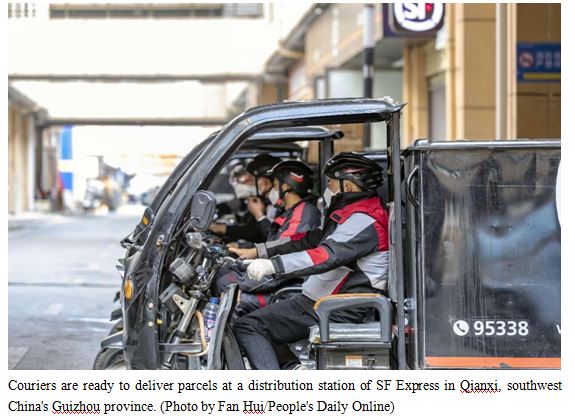By Wang Ke, People’s Daily
Wang Wei, who lives in Yuelu district of Changsha, central China’s Hunan province, is a frequent online shopper. Whenever he needs a refreshing cold drink or urgently requires medication late at night, he simply picks up his phone, opens an app, and places an order.
“Within half an hour, things I need are delivered right to my doorstep,” he said.
Instant retail, which features online real-time ordering and offline real-time delivery, leverages local retail supply to meet local instant demands.
Currently in China, an increasing number of products, ranging from fresh vegetables to bread and beverages, and from electronic devices to cosmetics, are being delivered to consumers faster through this method.
According to data from the Ministry of Commerce, the number of instant retail orders exceeded 40 billion in 2022, with a market size of over 500 billion yuan ($68.32 billion), and the market is expected to treble by 2025.
The final delivery from merchants to consumers is a crucial part of the commercial distribution system. In recent years, with the continuous advancement of China’s commercial distribution system, there has been ongoing innovation and optimization in the field of last-mile delivery. This has been driven by the accelerated integration of online and offline consumption, giving rise to new models of instant retail and allowing consumers to immediately get commodities they purchase.
The rapid development of instant delivery is driven by the significant demand from consumers, especially young consumers. According to a Accenture report, Chinese Gen-Zers place a greater emphasis on the speed of delivery, and over half of consumers born after 1995 hope to get same-day or even half-day delivery. Seven percent of consumers hope to receive their goods within two hours after placing an order.
“Instant retail, relying on internet trading platforms, is not only a new form of retail, but also a new model of consumption,” said Wu Chuanliang, an official with the Ministry of Commerce.
In the first three quarters of this year, China’s online retail sales reached 10.8 trillion yuan, a year-on-year increase of 11.6 percent, 4.8 percentage points higher than the growth of total retail sales of consumer goods.
The steady growth has brought good opportunities for the development of instant retail. Currently, the instant retail industry is showing a growing trend characterized by a wider range of product categories, expanded service areas, an expanding customer base, and increasingly diverse consumption scenarios.
“It was beyond my imagination that I could sell hundreds of thousands of goods a month,” said Liu, who runs a 80-square meter budget store in Tongzhou district, Beijing. Leveraging the delivery services provided by retail platforms, the service radius of this small store has expanded from 1-2 kilometers to 5-6 kilometers. Hundreds of orders are sent from the store every day, driving rapid growth of its sales.
“Technological transformation has brought about significant changes to both the production and consumption ends of the retail industry,” said Zhang Jixing, deputy director of the market research department of the Academy of China Council for the Promotion of International Trade.
New business forms such as social commerce and vertical e-commerce continue to emerge, while instant retail and home delivery models are flourishing. Such development is driving offline retailers to actively embrace online channels, not only providing convenience to consumers but also converting online traffic into new sources of orders.
According to a report by the China Chain Store and Franchise Association (CCFA), with the rapid development of the infrastructure for new business models and urban delivery networks, instant retail characterized by hour or minute delivery has become a new frontier for retail innovation.
An official with the CCFA told People’s Daily that instant retail, by integrating existing offline resources, enables online platforms to collaborate with offline retailers, creating a synergy where “1+1>2.” This is not only a necessity for the development of the industry but also a result of the advancement in cloud computing, big data, Internet of Things, and intelligent technology.
Hong Yong, an associate research fellow at the e-commerce research institute of the Chinese Academy of International Trade and Economic Cooperation, said the development of instant retail helps accelerate the digital transformation of traditional retail, facilitating the convergence of online and offline channels in the retail industry. It is expected to become a new driver of consumption growth, Hong added.














